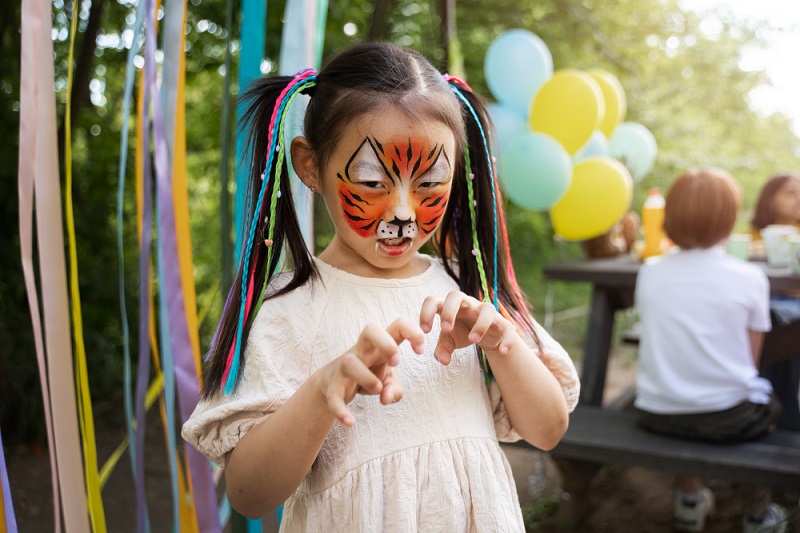Top 10 Safety and Hygiene Tips for Face Painting

Face painting can be a creative and fun activity that can bring joy to you and your children. Whether it’s for a birthday party, a festival, or any other occasion, face painting is a popular form of entertainment that never goes out of style. However, as much as it is a fun activity, it is also important to prioritize safety and hygiene when it comes to face painting. In this article, we will provide you with the top 10 safety and hygiene tips for face painting.
Use only high-quality face paints
When it comes to face painting, it is important to buy high-quality, approved face paints. These paints are specifically designed for use on the skin and are free from harmful chemicals that can cause skin irritation or other health issues. Always check the labels of the face paints you are using to ensure that they are safe and non-toxic. These products tend to cost more, but they pay off in every way as they are a sort of protection. So, the use of high-quality face paint is going to protect your skin from the irritation that can occur if you opt for using low-quality products.
Clean and sanitize your hands and tools
Before starting any face painting activity, it is important to clean and sanitize your hands and tools thoroughly. This helps to prevent the spread of germs and bacteria that can cause infections or other health issues. Use soap and warm water to wash your hands, and use a sanitizer to disinfect your tools before and after each use. If you want to feel even safer, consider using alcohol to clean your tools. This will for sure get rid of all the bacteria.
Use separate brushes and sponges for each person
The best thing that you can do to prevent the spread of germs and bacteria between different people is to use separate brushes and sponges for each person you are painting. This helps to prevent the transmission of infectious diseases and ensures that each person receives a clean and hygienic face painting experience. This is an absolute must and the most basic thing that you need to do. Every professional does this, and you should too!
Avoid using glitter and other loose materials
While glitter and other loose materials may look attractive, they can pose a safety hazard when used in face painting. These materials can get into the eyes or mouth and cause irritation or other health issues. Therefore, it is best to avoid using glitter and other loose materials when face painting. If you still want to opt for these types of materials, try consulting a professional who will advise you on which products are best for you. Fortunately, Australia has a large number of professional makeup artists, so you won’t have to look far to find one. The Internet makes it easy for you as you just need to type in something like “professional face painting in Sydney“.
Avoid painting over open wounds or cuts
If a person has an open wound or cuts on their face, it is important to avoid painting over it. Painting over an open wound can cause infection or other health issues. Instead, it is best to wait until the wound has healed before painting the face. If you still want to do face painting, I suggest you come up with a creative way that leaves the wound area clean while still going with the rest of the design. The first example that comes to mind is a flower. The wound can be the center of the flower, and you can paint the area around the wound.
Avoid using face paint on babies under six months old
It is not recommended to use face paint on babies under six months old, as their skin is still delicate and can easily become irritated. Instead, it is best to wait until the baby is older before introducing them to face painting. I am going to be harsh on this one; there is no need to paint a young child’s face. Health comes first!
Be aware of any allergies
Before starting any face-painting activity, it is important to be aware of any allergies that the person may have. Some people may be allergic to certain ingredients in face paints, such as latex or certain pigments. Always ask the person if they have any allergies before starting the face-painting activity.
Keep the paint away from the mouth and eyes
I don’t think that I need to explain this in detail. When face painting, it is important to keep the paint away from the mouth and eyes. This helps prevent the paint from being ingested or getting into the eyes, which can cause irritation or other health issues. If you accidentally get paint in the eyes, rinse them immediately with water and seek medical attention if necessary.
Monitor children closely
When face painting children, it is important to monitor them closely to ensure that they do not accidentally ingest the paint or get it in their eyes. Always supervise children during the face painting activity and remind them not to touch their faces or rub their eyes.
Remove the paint properly
After the face-painting activity is over, it is important to remove the paint properly. Use soap and warm water to wash the paint off the face, and use a gentle cleanser if necessary. Avoid using harsh chemicals or scrubbing too hard, as this can harm your skin. It is important to remove the paint as soon as possible. If you leave it on your skin for too long, you will damage your skin for sure, or at least irritate it.